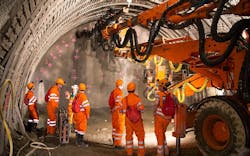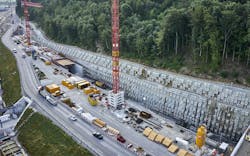In 2016, ground was broken on a major Swiss transit expansion project between Olten & Aarau. It contains ten sub-projects and will cost approximately $865 million, but the Swiss believe it well worth the expense. The project plans include a fourth1.5-mile-long track between Dulliken and Däniken, and the double-track, roughly 2-mile-long Eppenberg Tunnel, plus comprehensive measures for its connection.
By the end of next year, the four-track extension is expected to relieve one of the most severe bottlenecks on the east-west axis of the Swiss rail network. This development is a key project for more efficient passenger transport and provides sufficient capacity for freight transport in the long term.
In addition to the longer duration of this project, part of its complexity lies in the tunnel excavation. Different methods must be used for different sections, and a multitude of rock anchors, shotcrete, and reinforcement meshes were necessary to secure the land under construction. Prefabricated concrete elements also came into play as extensive load distribution plates of the pre-stressed anchors on the pit wall. Plus, the spatial shape of the pit was also a major challenge, as its lines in the plan have different radii but are almost never straight. In the cross-section, the different inclination of the slope must also be considered, along with various parameters in the longitudinal axis.
“The geology is very problematic and the spatially very complex shape of the excavation pit is a major challenge for us,” explains Rainer Hohermuth, a civil engineer working with the engineering consortium as the project manager responsible for this specific construction stage.
To ensure that the anchors were properly placed, and that no collisions occurred, 3D planning was imperative—but, 3D alone was not sufficient. Hohermuth clarified, “It should also be possible for the anchors to store all the information required for construction as attributes, and to automatically generate a complete list of anchors at the touch of a button with all this information—including all the information for pegging out.”
To meet these requirements, the project managers turned to ALLPLAN, which developed a tool that included the function of parametric anchors so the draftsman could use it to assign all the desired data and descriptions to every anchor, and also use it to spatially position the anchors. Then the tool applied this information to generate the list of anchors, which could then be transferred directly to construction without further editing.
This increase in efficiency should not be underestimated, especially pertaining to the development of layouts and anchor lists. Working in 3D allowed optimal visualization for congested working areas, but working with BIM streamlined planning, reporting, and the delivery of necessary data to other project team members.
According to Hohermuth, “The client requested that we provide visualization with the individual construction work steps for more clarity. Thanks to 3D planning in Allplan, this request could also be granted.”
Editor's Note: Scranton Gillette Communications and the SGC Infrastructure Group are not liable for the accuracy, efficacy and validity of the claims made in this piece. The views expressed in this content do not reflect the position of the Roads & Bridges' Editorial Team.

